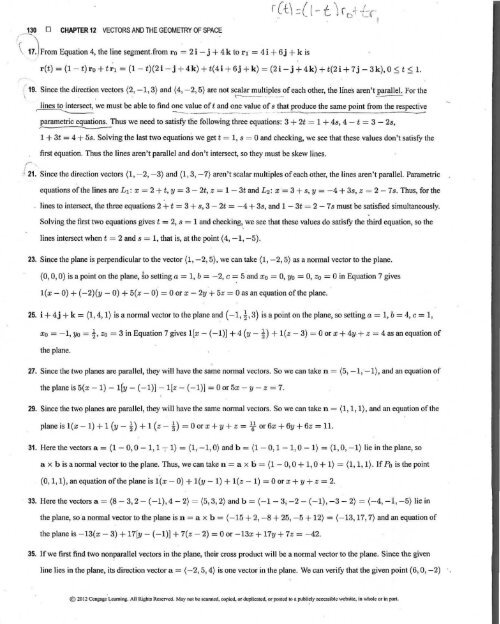Exercicios resolvidos James Stewart vol. 2 7ª ed - ingles
You also want an ePaper? Increase the reach of your titles
YUMPU automatically turns print PDFs into web optimized ePapers that Google loves.
130 D CHAPTER 12 VECTORS AND THE GEOMETRY OF SPACE<br />
\~~ From Equation 4, the line segment. from ro ~ 2 i - j + .4 k to r 1 = 4 i + 6j + k is<br />
r (t) = (1 - t)ro +tr1 = (1 - t)(2 i - j +4 k) +t(4 i + 6j + k ) = (2 i -j +4k) +t(2 i + 7j- 3k), 0 ::=; t ::=; 1.<br />
l 19. Since the direction vectors (2, -1, 3} and (4, - 2, 5} are not scalar multiples of each other, the Lfnes aren't parallel. For the<br />
\ ' ' \- -<br />
lines to intersect, we must be able to find one value oft and one value of s that produce the same point from the respective<br />
..------______: ----·----- --~·-----------"'--<br />
parametric equations. Thus we ne<strong>ed</strong> to satisfy tlie following three equations: 3 + 2t = 1 + 48, 4 - t = 3 - 28,<br />
...-----<br />
1 + 3t = 4 + 5s. Solving the last two equations we get t = 1, 8 = 0 and checking, we see that these values don't satisfy the<br />
first equation. Thus the lines aren't parallel and don't intersect, so they must be skew lines.<br />
r<br />
·• 21. Since the direction vectors (1, - 2, - 3} and (1, 3, -7) aren't scalar multiples of each other, the lines aren't parallel. Parametric<br />
equations of the lines are L1: x = 2 + t, y = 3- 2t, z = 1 - 3t and L2: x ·= 3 + 8, y = -4 + 38, z = 2 -78. Thus, for the<br />
lines to intersect, the three equations 2 + t = 3 + 8, 3 - 2t = -4 + 3s, and 1-3t = 2-78 must be satisfi<strong>ed</strong> simultaneously.<br />
Solving the first two ~quations gives t = 2, 8 = 1 and checking,_ we see that these values do satisfy the third equation, so the<br />
lines intersect when t = 2 and 8 = 1, that is, at the point ( 4, -1, -5).<br />
23. Since the plane is perpendicular to the vector (1, -2, 5), we can take (1, - 2, 5} as a normal vector to the plane.<br />
(0, 0, 0) is a point on the plane, so setting a= 1, b = -2, c = 5 and xo = 0, yo = 0, z 0 = 0 in Equation 7 gives<br />
1(x - 0) + (-2)(y- 0) + 5(z - 0) = 0 or x- 2y + 5z = 0 as an equation of the plane.<br />
25. i + 4j + k = (1, 4, 1} is a normal vector to the plane and (- 1, ~, 3) is a point on the plane, so setting a= 1, b = 4, c = 1,<br />
xo = - 1, yo = ~, zo = 3 in Equation 7 gives 1 (x - (-1)] + 4 (11 - ~) + 1(z - 3) = 0 or x + 4y + z = 4 as an equation of<br />
the plane.<br />
27. Since the two planes are parallel, they will have the same normal vectors. So we can taken = (5, -1, - 1), and an equation of<br />
the plane is5(x-1) -1(y- (- 1)]-1[z- (-1)] = Oor5x -11- z = 7.<br />
29. Since the two planes are parallel, they will have the same normal vectors. So we can taken = (1, 1, 1), and an equation of the<br />
plane is 1(x- 1) + 1 (y - ~) + 1 (z - ~) = 0 or x + y + z = Jt or 6x + 6y + 6z = 11.<br />
31. Here the vectors a= (1- 0, 0 - 1, 1 1 1) = (1, -1, 0) and b = (1 - 0, 1- 1, 0- 1) = (1, 0, - 1) lie in the plane, so<br />
ax b is a normal vector to the plane. Thus, we can taken= ax b = (1 - 0, 0 + 1, 0 + 1) = (1, 1, 1}. If P o is the point<br />
(0, 1, 1), an equation of the plane is 1(x- 0) + 1(y - 1) + 1(z - 1) = 0 or x + y + z = 2.<br />
33. Here the vectors a = (8 - 3, 2 - ( - 1), 4- 2} = (5, 3, 2) and b = (-1 - 3; - 2 - ( -1), -3- 2} = (-4, - i , - 5) lie in<br />
the plane, so a normal vector to the plane is n = a x b = (- 15 + 2, -8 + 25, - 5 + 12) = (-13, 17, 7) and an equation of<br />
the plane is - 13(x - 3) + 17[y- (-1)) + 7(z - 2) = 0 or -13x + 17y + 7z = -42.<br />
35. If we first find two nonparallel vectors in the plane, their cross product wi ll be a normal vector to the plane. Since the given<br />
line lies in the plane, its direction vector a= (-2, 5, 4) is one vector in the plane. We can verify that the given point (6, 0, -2)<br />
© 2012


